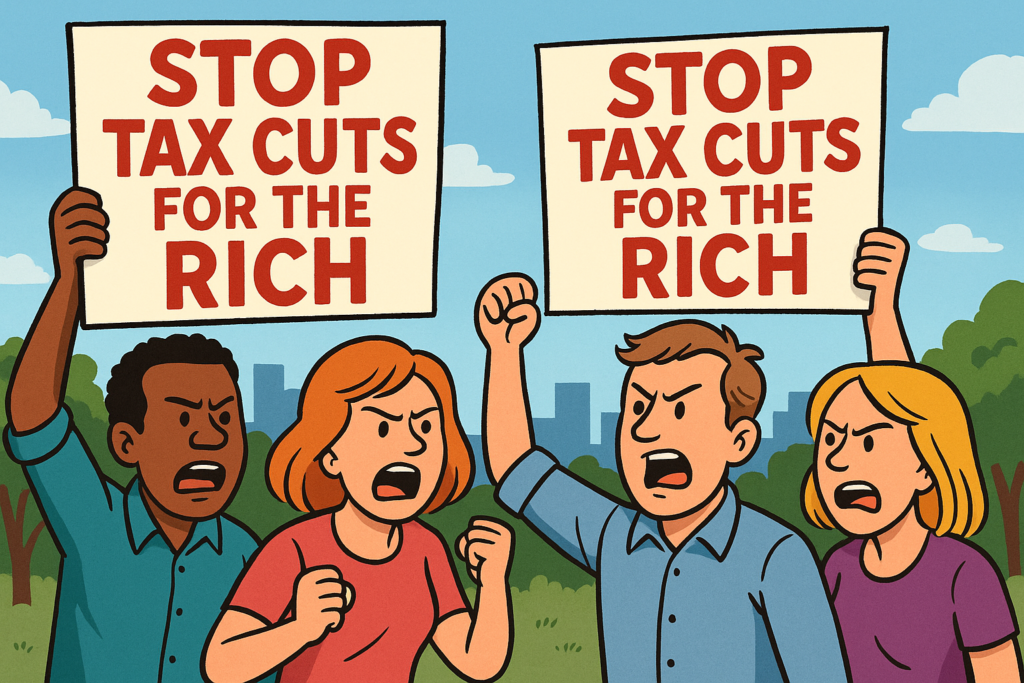
AROUND the world, over the past 50 years, wealthy individuals have benefited significantly from tax cuts implemented by their respective governments. This has been especially true in advanced economies. The economic consequences of such measures remain hotly debated among economists and politicians.
However, empirical research shows that tax cuts for the rich do not deliver the benefits claimed by their proponents. Instead, they exacerbate inequality, widening the gap between the rich and the poor. These tax cuts have also been found to have no meaningful impact on economic growth or job creation for the broader population.
Despite this evidence, many policymakers still cling to the misguided belief that tax cuts for the wealthy are beneficial.
The OECD experience
The Organisation for Economic Co-operation and Development (OECD) is a group of 38 mostly advanced economies, which coordinate policies around the objective of economic growth and the improved standards of living, for the good of their respective citizens. It is dominated by advanced economies, although a few emerging economies such as Mexico and Chile are also a part of the grouping.
In 2022, some researchers at Kings College, in London, released their study which evaluated the impacts of major tax cuts on 18 OECD countries, for a 50-year period spanning 1965 to 2015. Their study scrutinised personal income taxes, corporate taxes, and taxes on assets and capital. The research’s comprehensiveness made it special since studies, which focus on the effects of tax reductions for the rich, are very hard to come by.
The study reported that, during the 1920s to 1940s, OECD governments began to implement progressive taxes, which ensured that the rich paid relatively more in taxes than the poor. This was because the governments were pressed for revenue, since the World I and II had depleted their labour force populations and therefore, their respective tax bases.
As a result, with only a few available workers in their countries, governments resorted to charging higher taxes on the rich, in order to support their own tax revenues.
- Combating illicit financial flows crucial for Africa’s development
- Govt tightens screws on counterfeits
- Consequences of tax cuts for the rich
- Economic consequences of tax cuts for the wealthy
Keep Reading
Consequently, the highest tax rate that rich citizens paid on their income averaged around 60%, which was a lot and progressive. In essence, the rich were being taxed at significantly higher rates than the poor. This went on until the early 1980s.
However, from the early 1980s, these OECD countries witnessed a sharp turning point. Their governments began to reduce average tax rates for the rich. Such moves may have been stimulated by the need of politicians to appease the rich, some of whom were their sponsors.
There was also the wrong assumption by some governments that “trickle down economics” would work wonders through the implementation of less progressive taxes.
Trickle down economics is a concept which posits that, when the rich are given greater space to generate and accumulate more wealth, their benefits will flow down to the poor. The assumption is that the greater the share of wealth held by the rich, the more that it can be used to facilitate more economic growth, through- their consumption of more goods and services, investment in the expansion of their businesses, etc.
However, as will be explained later in this article, several economists argue that trickle down economics does not exist. The OECD countries highlighted in the study were also motivated to implement the less progressive taxes, by their respective labour force populations, which had since replenished since the end of the World Wars.
In other words, their tax bases had been restored and they could afford to establish more lenient tax rates.
In the same period, capital and labour began to be increasingly globally-mobile. That means, both investors and high income workers, who identified as rich, could easily migrate to lower tax jurisdictions, if their own countries chose to impose sharply progressive taxes. It is such outcomes which began to undermine the previously highly-progressive tax systems, of the post-war era.
Between 1980s and 2015, for example, average tax rates on the top-income earners dropped from a high of 60% to only 40% in the 18 OECD countries. Since then, major tax reductions have been increasingly implemented in many other countries beyond the OECD.
Motivation for softer tax regimes
Although strong indications show that less progressive taxes are not ideal, governments which have been implementing them, have been relying on alternative economic theories, which advocate for them.
Unfortunately, as will be seen later in this article, these alternative theories have not been proven. They are not valid in the real world. Some of those incorrect theories are explained below.
Firstly, some economic theories suggest that lower taxes for the rich motivate high-income workers to work even harder. Such theories suggest that affluent employees end up working for longer hours and enhancing their efforts, in response to a reduction in tax rates on their wages. The idea is that the workers are motivated to work harder in their roles in order to earn more income arising from the less progressive taxes.
Unfortunately, in the real world, this has not been proven to be true. Major tax cuts for the rich have been observed to have no notable positive effects on economic growth and employment. Rather, available studies have argued that lower taxes on the rich, negatively impact economic growth, especially when the rich begin to bargain more forcefully for higher wages.
The forceful bargaining would be aimed at maximising the elite workers’ own benefits, to arise from the lower taxes. This greed has been noted to push up wage costs for entrepreneurs and result in lower expansion of investments and job creation, instead.
Other theories which support tax cuts for the rich, insist that reductions in company taxes can lead to an increase in corporate savings, which can be used for the expansion of business activities.
However, actual research, beyond the theories, has dispelled the arguments made by such theories. Real world studies have found that, although tax cuts increase the financial savings of companies, these savings are not necessarily deployed towards real investment — which relates to the production of goods and services. Instead, the savings are typically stockpiled in bank accounts and other financial products such as bonds and Treasury Bills, among other products.
What is interesting is that, even the same theorists who advocate for less progressive taxes agree that their proposals cause higher income and wealth inequalities, making the gap between the rich and the poor to widen.
With regards to that, general economics principles and research evidence prove that widening inequalities can curtail economic growth. Due to the world’s adoption of less progressive tax regimes, wealth has become increasingly concentrated in the hands of the few. The gap between the rich and the poor has widened sharply.
For example, the share of wealth currently held by the richest 1% of the population in the United States, has reached an astonishing 34% of the country’s total wealth. The trend is generally the same for many OECD countries.
In nations such as Brazil, India and China, which are not in the OECD, the situation is starker, as the top 1% now own 48%, 41% and 31% of total national wealth, respectively.
Nations such as Zimbabwe and much of Sadc, have not been spared of these inequalities as they make up nine of the 30 countries with the worst inequalities in the world.
On the other hand, other empirical studies have proven that entrepreneurs tend to take more risks and accelerate their pace of innovation, when tax systems are progressive. Progressive tax rates are therefore suitable for stimulating job creation and economic growth, arising from the activities of such entrepreneurs.
Implications for Zimbabwe
Looking at all references to empirical studies above, it is convincing that reducing taxes for the rich is not ideal. Unfortunately, if one country tries to implement thoroughly-progressive taxes on its own, it would likely lose some of its entrepreneurs and its wealthy working class.
The aforementioned would simply migrate to countries with lower tax rates. Therefore, due to the mobility of capital and labour in today’s world, reverting to thoroughly-progressive taxes, would require a global effort, whereby, all significant economies comply with such a reversion.
In that regard, at appropriate regional and international forums, Zimbabwe should convey the importance of progressive taxes, so that it can get buy-in from other countries, on their worldwide adoption.
Additionally, the government must be careful with the issue of providing tax incentives for the rich. This means, exemptions which permit non-payment of taxes, such as through the granting of Special Economic Zone (SEZ) status, should be handled with discretion.
If the SEZ status lapses after a period of five years, for example, the government must not extended it beyond that. As has been adequately described above, trickle-down economics does not always work. In several cases, the tax exemptions do not spill over to the rest of the country, as intended.
Today’s world is encumbered by the rise of multiple economic threats such as impeding job losses owing to artificial intelligence and automation, the decline of manufacturing as it migrates to key emerging markets, “greedflation” and inflation, among others. These emerging challenges make it urgent for governments around the world to reduce privileges for the rich, so that they can balance their revenues, under challenging circumstances.
Tutani is a political economy analyst. — tutanikevin@gmail.com






